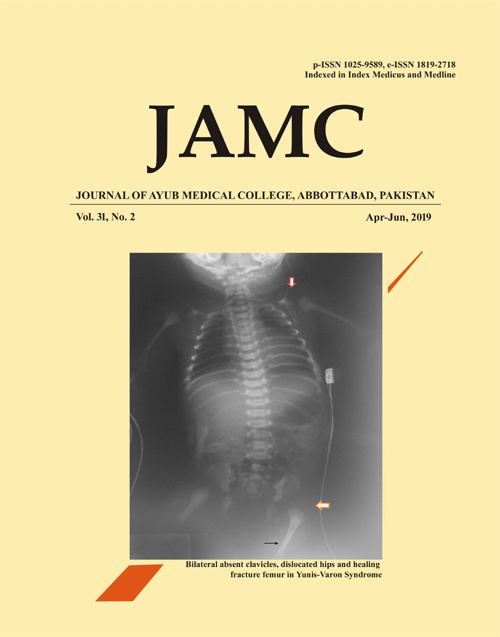DIVERSE ANATOMICAL CONFIGURATION OF RECURRENT LARYNGEAL NERVE IN RELATION TO INFERIOR THYROID ARTERY, AN EXPERIENCE WITH 51 THYROIDECTOMIES
Abstract
Background: Objective of the study is to elaborate the anatomical variants of recurrent laryngeal nerve in relation to inferior thyroid artery, encountered during thyroidectomy operation. It is descriptive, case series, conducted at the Department of Ear Nose & Throat, Combined Military Hospital, Abbottabad. The study was conducted from January 2016 to September 2017. Methods: Fifty-one patients underwent extra-capsular thyroidectomy in general anaesthesia. The dissection was carried out in a standard way in all patients. Recurrent laryngeal nerves were identified and exposed in every patient, and their anatomical relations were recorded in database. Results: Recurrent laryngeal nerve was seen over riding the ramification of inferior thyroid artery in majority of left sided dissected specimen, however on the right side the principal nerve was found to be ascending through the branches of inferior thyroid artery. Conclusion: Iatrogenic vocal cord paralysis has sinister implication on quality of life of the patient undergoing thyroidectomy. Anatomic variants of recurrent laryngeal nerve are well known and frequent. The disastrous outcome of inadvertent recurrent laryngeal nerve trauma can be adequately prevented by thoroughly knowing its anatomical variants, and intra-operatively identifying and exposing the principal nerves.
Keywords: Thyroidectomy; recurrent laryngeal nerve; anatomy; iatrogenic; vocal cord paralysisReferences
Giddings AE. The history of thyroidectomy. J Royal Soc Med 1998;91(33_suppl):3-6.
Friedrich T, Steinert M, Keitel R, Sattler B, Schonfelder M. The incidence of recurrent laryngeal nerve lesions after thyroid gland surgery-a retrospective analysis. Zentralbl Chir 1998;123(1):25-9.
Hayward NJ, Grodski S, Yeung M, Johnson WR, Serpell J. Recurrent laryngeal nerve injury in thyroid surgery: a review. ANZ J Surg 2013;83(1-2):15-21.
Zakaria HM, Al Awad NA, Al Kreedes AS, Al-Mulhim AMA, Al-Sharway MA, Hadi MA, et al. Recurrent laryngeal nerve injury in thyroid surgery. Oman Med J 2011;26(1):34-8.
Chiang FY, Wang LF, Huang YF, Lee KW, Kuo WR. Recurrent laryngeal nerve palsy after thyroidectomy with routine identification of the recurrent laryngeal nerve. Surgery 2005;137(3):342-7.
Jatzko GR, Lisborg PH, Müller MG, Wette VM. Recurrent nerve palsy after thyroid operations--principal nerve identification and a literature review. Surgery 1994;115(2):139-44.
Chaudhary IA, Samiullah MR, Masood R, Majrooh MA, Mallhi AA. Recurrent laryngeal nerve injury: an experience with 310 thyroidectomies. J Ayub Med Coll Abbottabad 2007;19(3):46-50.
Khan JS. Recurrent laryngeal nerve in thyroid surgery: Is routine identification necessary? J Rawal Med Coll 2008;12(1):16-8.
Yalcxin B. Anatomic configurations of the recurrent laryngeal nerve and inferior thyroid artery. Surgery 2006;139(2):181-7.
Ready AR, Barnes AD. Complications of thyroidectomy. Br J Surg 1994;81(11):1555-6.
Bergamaschi R, Becouarn G, Ronceray J, Arnaud JP. Morbidity of thyroid surgery. Am J Surg 1998;176(1):71-5.
Wagner HE, Seiler C. Recurrent laryngeal nerve palsy after thyroid gland surgery. Br J Surg 1994;81(2):226-8.
Rathi PK, Shaikh AR, Shaikh GA. Identification of recurrent laryngeal nerve during thyroidectomy decreases the risk of nerve injury. Pak J Med Sci 2010;26(1):148-51.
Barczyński M, Konturek A, Pragacz K, Papier A, Stopa M, Nowak W. Intraoperative nerve monitoring can reduce prevalence of recurrent laryngeal nerve injury in thyroid reoperations: results of a retrospective cohort study. Worl J Surg 2014;38(3):599-606.
Abadin SS, Kaplan EL, Angelos P. Malpractice litigation after thyroid surgery: the role of recurrent laryngeal nerve injuries, 1989-2009. Surgery 2010;148(4):718-23.
Downloads
Published
How to Cite
Issue
Section
License
Journal of Ayub Medical College, Abbottabad is an OPEN ACCESS JOURNAL which means that all content is FREELY available without charge to all users whether registered with the journal or not. The work published by J Ayub Med Coll Abbottabad is licensed and distributed under the creative commons License CC BY ND Attribution-NoDerivs. Material printed in this journal is OPEN to access, and are FREE for use in academic and research work with proper citation. J Ayub Med Coll Abbottabad accepts only original material for publication with the understanding that except for abstracts, no part of the data has been published or will be submitted for publication elsewhere before appearing in J Ayub Med Coll Abbottabad. The Editorial Board of J Ayub Med Coll Abbottabad makes every effort to ensure the accuracy and authenticity of material printed in J Ayub Med Coll Abbottabad. However, conclusions and statements expressed are views of the authors and do not reflect the opinion/policy of J Ayub Med Coll Abbottabad or the Editorial Board.
USERS are allowed to read, download, copy, distribute, print, search, or link to the full texts of the articles, or use them for any other lawful purpose, without asking prior permission from the publisher or the author. This is in accordance with the BOAI definition of open access.
AUTHORS retain the rights of free downloading/unlimited e-print of full text and sharing/disseminating the article without any restriction, by any means including twitter, scholarly collaboration networks such as ResearchGate, Academia.eu, and social media sites such as Twitter, LinkedIn, Google Scholar and any other professional or academic networking site.










